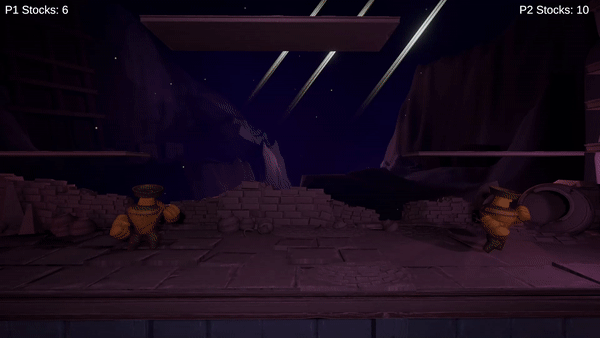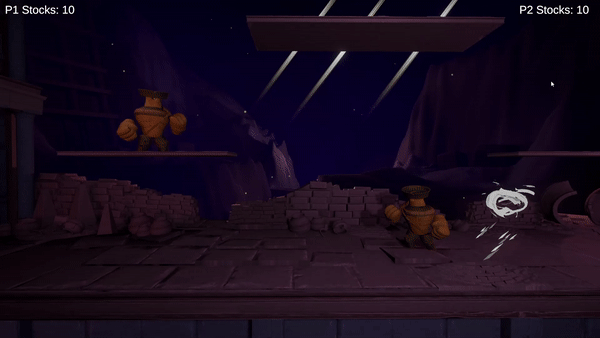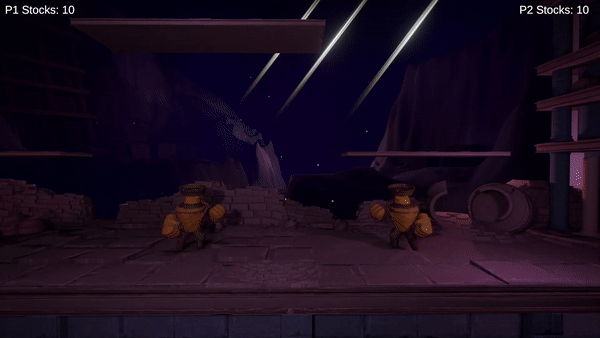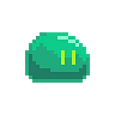Untitled Pot Game

The current project I'm working on is a fast-paced 1v1 platform fighter (think games like Smash Bros. or Rivals of Aether), where if you get hit once, you die. I'm working as the game's lead designer, programmer, and VFX artist. When coming up with the game's core premise, I was inspired by fighting games with similar premises. Games like Nidhogg, Divekick, and Footsies take away some of the auxiliary elements of fighting games, and simplify them down to the "neutral" game. "Neutral" is a technical term in fighting games that refers to the point in the game where neither player has a significant positional advantage, forcing them to take risks for that advantage. Several games have been designed around exploring the neutral game in the traditional fighting game space, but I wanted to build a game around these concepts in the platform fighter subgenre.
Player Actions and Movement

When making a fighting game, it's important to design other elements of the game around what characters are able to do. This is especially true of platform fighters, where characters have a larger range of motion than traditional fighting games. However, one of the core goals for the game was to keep it as simple as possible. I designed the game to be played with only a joystick and two buttons to make it as accessible as possible. One of the major design challenges I had to overcome was finding ways to preserve the depth that the free-form movement of platform fighters provide without relying on the complexity of things like blocking, grabs, or input attacks. In short, I had to design the game to have depth driven only by gameplay that rewards good movement and positioning
Many of the options conventionally available in platform fighters are already pretty deep and intuitive. Things like falling quicker by pressing down on the stick while in the air are intuitive staples of the genre. However, one of the most iconic techniques unique to platform fighters, wave-dashing, was particularly difficult to implement into the game. Wave-dashing allows players to quickly reposition on the ground by jumping and then doing an aerial dash diagonally downwards into the ground. This carries their aerial dash momentum into a slide.
Because my game only has a jump and attack button, there seemed to be no way to implement wave-dashing, as the game has no air dash button. The solution I came up with was triggering a wave-dash when the player is holding diagonally downwards during the start up of a jump. This way, the input feels mechanically consistent with other games in the genre (which do the same input with an extra button press) while also being tied to an input that players aren't likely to trigger accidentally (holding downwards while jumping).
Character Respawns

One area I sought to improve heavily was the character respawning system that most platform fighters up to this point have used. Traditionally, when characters lose a life in a platform fighter, they respawn with a small amount of invincibility to prevent them from being vulnerable immediately after coming back into the fight. However, this causes a lot of negative effects for these games in the long run.
When players respawn with invincibility, they're able to attack their opponent for a small period of time with wild abandon without considering the risk-reward of the options that they're picking. This leads to a game of cat and mouse where the player who just took a stock is now forced to play defensively, which ultimately slows down the pace of the game.
The solution I came up with is largely a result of this game being a 1v1 experience. When someone loses a life, the game checks to see which side of the stage their opponent is on. Then, it respawns them safely on the side of the stage opposite to their opponent. This allows the game to keep moving at a fast pace while keeping respawning players safe from spawn camping.
Lessons Learned
The game is still in development, so I'm sure that there's still much more to learn. However, one of the major lessons from early production of the game was learning how to work with other members of the team to create a cohesive experience. A lot of my previous work has been solo projects, so finding ways to communicate complex ideas is a skill I've had to develop a lot over the course of this project.
For example, frame data in fighting games is an incredibly important element of a game that often represents itself from a design perspective as a set of numbers on a page. Some attacks need hitboxes active on one frame and need to end on a different one. Those numbers directly translate to frames certain things have to be happening during certain animations. I started writing lengthy documents containing the frame data of each attack along with models posing in the rough pose characters would need to be in and reference images for similar attacks in other games. This allowed the animator to understand the mechanical needs for the animations they were working on much more effectively.
Project in Development
The Untitled Pot Game (working title) is in an alpha state, and there are still a number of things that are likely to be implemented into the game. I've currently designed 3 additional characters, each of which will have slightly different movement values and entirely different movesets to sell the fantasy of their individual character archetypes. Additionally, I intend to include a large number of accessibility features to make the game appealing to as many fans of platform fighters as I can. I hope I can share these developments soon!
